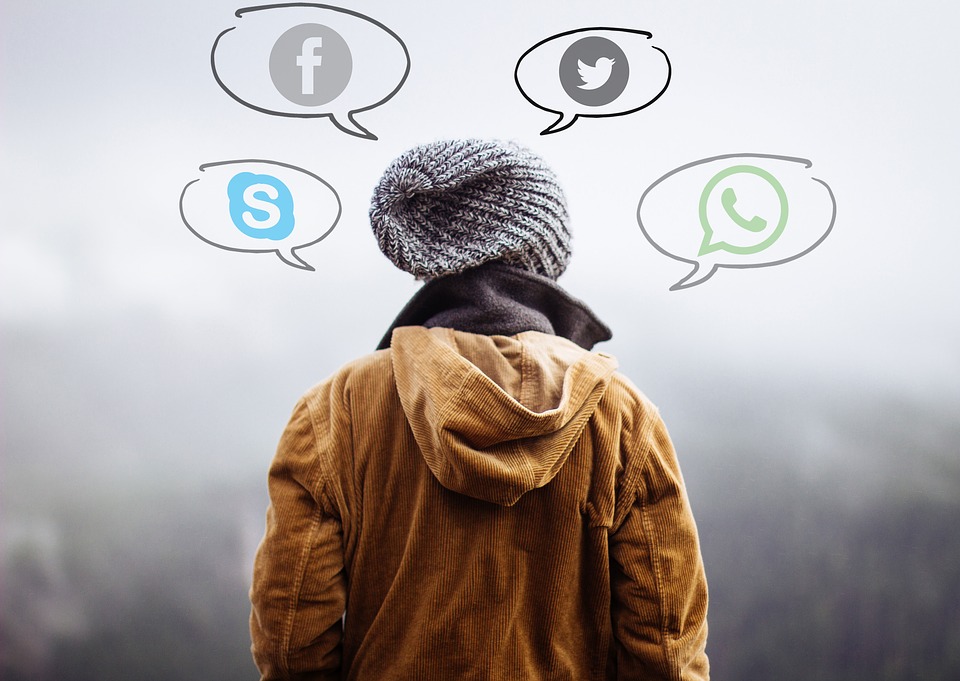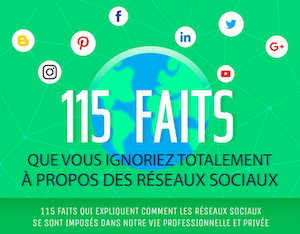Ce dossier propose des pistes concrètes pour développer l’esprit critique des jeunes (et des moins jeunes!) dans l’utilisation des médias sociaux en éducation. D’autres articles à ce sujet se trouvent dans notre périodique professionnel.
Un dossier conjoint École branchée et Carrefour éducation
Les médias sociaux occupent aujourd’hui une place prépondérante dans le quotidien de chacun. Par exemple, selon l’infographie « 115 faits surprenants sur les réseaux sociaux », 92 % des ados disent aller tous les jours sur les réseaux sociaux et 71 % d’entre eux utilisent plusieurs réseaux sociaux. De plus, 58 % des adultes auraient un profil Facebook.
Élèves et enseignants n’y échappent pas, et on s’en passe parfois difficilement. À ce propos, toujours selon l’infographie mentionnée précédemment, 18 % des gens seraient incapable de passer plusieurs heures sans aller sur Facebook!
Les plateformes d’interaction sociale présentent plusieurs dangers, dont la désinformation, mais aussi plusieurs avantages lorsqu’elles sont utilisées adéquatement. C’est pourquoi il importe d’éduquer les jeunes à cet effet.
Or, ces outils interactifs s’implantent lentement dans le milieu de l’éducation. Pour plusieurs raisons, l’apprentissage des médias sociaux, ou par leur entremise, n’est pas institutionnalisée et s’effectue bien souvent par les enseignants de manière autodidacte.
Ce dossier vise à aborder le sujet sous plusieurs angles. Tout d’abord, les concepts importants seront définis. On présentera ensuite différentes idées d’activités intégrant les médias sociaux à l’apprentissage. On y verra également leur utilité pour la formation continue des enseignants, notamment par le biais des communautés d’apprentissage virtuelles et des communautés de pratique, pour finalement survoler les impacts positifs de ces médias sur la vie des élèves.
Sommaire
- Réseaux sociaux, médias sociaux ou Web 2.0 : du pareil au même?
- Éducation critique aux médias sociaux
- Des idées d’utilisation des médias sociaux en classe
- Les médias sociaux au service des enseignants
- Médias sociaux : des impacts positifs chez les élèves
- Bibliographie
Réseaux sociaux, médias sociaux ou Web 2.0 : du pareil au même?

Les termes réseaux sociaux, médias sociaux ou Web 2.0 sont souvent utilisés pour désigner des plateformes ou des outils interactifs du Web. Il importe néanmoins de bien définir ces concepts, qui ne constituent pas un ensemble homogène et se distinguent à plusieurs égards.
Web 2.0
Le terme Web 2.0 renvoie plus généralement aux plateformes qui permettent aux diverses applications des réseaux sociaux d’être utilisées par les usagers afin de créer, distribuer, partager ou manipuler du contenu libre d’accès.
Médias sociaux
Hétérogènes, les médias sociaux regroupent quant à eux une grande variété de plateformes en ligne ou d’applications mobiles. Ils se définissent comme un groupe d’outils reposant sur les fondements du Web 2.0, permettant la communication et la collaboration grâce à la création et l’échange de contenus que produisent les usagers de ces réseaux.
Les sites de réseautage social (Social Networking Sites, ou SNS) sont parmi les médias sociaux les plus connus et les plus populaires, mais ils sont loin d’être les seuls puisqu’il existe près d’une dizaine de réseaux du genre.
De manière générale, voici les grandes catégories de médias sociaux :
1. Réseautage social
Ces sites facilitent les interactions sociales et le partage d’information entre les membres de groupes d’intérêts ou entre amis. À l’intérieur d’un système délimité, les usagers se construisent un profil public ou semi-public, se créent un réseau de contacts avec d’autres usagers et le parcourent afin d’échanger. Ce type de réseau augmente aussi la prise de conscience périphérique, c’est-à-dire qu’un usager peut afficher des repères temporaires sur sa vie quotidienne via son interface. Facebook (famille et amis), LinkedIn (contacts professionnels et orientation) et twitter (micro-blogue entre contacts) sont parmi les plateformes les plus utilisées.
2. Édition et partage de médias et contenus
Ces sites permettent aux utilisateurs de produire, éditer, développer ou partager leur propre contenu. WordPress, Twitter, YouTube, Snapchat et Pinterest sont des outils d’édition, alors que Google Drive, DropBox, WeTransfer ou Sendspace favorisent le partage de médias.
3. Manipulation de médias et mashups
Avec ces sites, les utilisateurs peuvent éditer, partager ou modifier du matériel numérique comme des vidéos, du matériel audio ou des photos. YouTube, Flickr et Instagram sont intéressants pour l’édition et le partage de vidéos et de photos. Les sites FotoFlexer, Picnik, Splashup (photos), Toondoo (bandes dessinées) et Voice Thread (audio) sont aussi intéressants dans le domaine de l’édition ainsi que du mashup (utilisation et modification de fichiers vidéo, audio ou photo déjà édités par d’autres).
4. Messagerie instantanée et espaces de conversation
Ces plateformes offrent la possibilité de discuter avec d’autres utilisateurs en temps réel ou en différé. Messenger et Skype sont au nombre des messageries instantanées qui permettent même la conversation vidéo. Des espaces comme Edmodo ou Google Classroom, conçus pour l’éducation, ou les groupes fermés de Facebook permettent quant à eux des interactions générales avec tous les utilisateurs, ou de manière plus personnalisée via la messagerie instantanée. La visioconférence de groupe peut aussi se dérouler sur les interfaces Adobe Connect, Zoom, BlueJeans, Skype, Facebook Live, Google Hangouts ou Periscope. Parmi les avantages, notons que certaines de ces plateformes permettent d’enregistrer les conversations afin de les réécouter ultérieurement au besoin. Voyez cet exemple d’enregistrement Periscope dans lequel M. Claude Frenette, conseiller pédagogique, parle de rétroaction avec les TIC.
5. Jeux en ligne et mondes virtuels
Ces jeux favorisent les interactions entre les utilisateurs grâce à la participation des joueurs dans l’arène virtuelle ou la messagerie instantanée. Les usagers créent un avatar et l’incarnent dans un monde entièrement créé par eux. Différents aspects sociaux de la « vraie vie » s’y retrouvent (territoire, système politique, langue, monnaie, etc.). Le jeu Second Life fait notamment fait de cette catégorie.
6. Marques-pages sociaux
Ces applications permettent d’annoter du texte ou des images disponibles sur le Web pour ensuite les partager avec d’autres utilisateurs. Pinterest, Pearltrees, Diigo et Del.icio.us sont des outils de ce genre.
7. Wikis et outils d’édition collaboratifs
Ces technologies offrent aux usagers la possibilité de collaborer au design, à l’édition et au développement de contenu numérique. Ouverte à tous, l’encyclopédie en ligne Wikipédia (également disponible en application mobile) est un bon exemple de Wiki. Pour la collaboration, pensons également à Google Docs et Office 365, très répandus en milieu scolaire. Enfin, les dictionnaires collaboratifs tels Bab.la et Vocabulary.com font aussi partie de ce type de plateformes.
8. Syndication
Grâce à l’utilisation de Tweetdeck, de Netvibes et même de fils RSS (Really Simple Syndication), les usagers peuvent recevoir une notification lorsqu’il y a des changements sur leurs sites favoris.
Ces distinctions établies et les concepts mieux définis, il sera maintenant plus simple de se pencher sur l’apport du Web 2.0 et des médias sociaux dans l’éducation.
Éducation critique aux médias sociaux

Les plateformes de réseautage social connaissent une croissance fulgurante. Très populaires auprès des jeunes, elles favorisent notamment l’édition et le partage de contenus. Or, dans ce contexte de transmission facile et rapide, une information (vraie ou fausse) peut rapidement devenir virale (être propagée à un vaste auditoire de façon très rapide), qu’on le veuille ou non. Celle-ci est par la suite difficile à retirer des réseaux, même si des options de signalement existent. D’ailleurs, bon nombre d’utilisateurs ne connaissent pas toutes les politiques d’utilisation de ces sites, ou n’ont pas conscience des conséquences de leurs agissements sur ces sites. C’est pourquoi il est si important d’entreprendre une démarche d’éducation critique aux médias sociaux auprès des jeunes.
Comportant des enjeux aussi bien techniques qu’éthiques, cette éducation favoriserait l’habileté à utiliser de tels outils. Elle permettrait également la réflexion sur les enjeux liés à la protection de la vie privée des utilisateurs ou des personnes qui s’y retrouvent parfois malgré elles (propos diffamatoires ou dégradants à leur insu, par exemple).
Le développement de saines habiletés d’utilisation des sites de réseautage social permet aux jeunes de mieux gérer les informations s’y retrouvant et ainsi mieux les utiliser dans leur vie personnelle et académique. L’entrainement, le support et les interventions pédagogiques sont d’ailleurs nécessaires à cet effet pour que la portée des actions virtuelles soit bien mesurée.
À cet effet, l’organisme Habilomédias propose aux parents et aux enseignants une foule de ressources éducatives permettant de cibler différents enjeux relatifs à la littératie numérique. On peut notamment parcourir la liste des jeux éducatifs, qui s’adressent directement aux jeunes en leur permettant d’exercer leur sens critique de façon amusante.
Voyez également les fiches d’activités pédagogiques de l’équipe TacTIC du CFORP sur l’identité et la citoyenneté numérique. On en trouve pour les classes à partir du 2e cycle du primaire, et même pour les parents.
Enfin, voici quelques autres idées d’activités pédagogiques permettant aux jeunes de réfléchir sur les médias sociaux et l’utilisation qu’ils en font.
En informatique
Dans le cadre d’un cours d’informatique, un objectif pourrait être de favoriser la maîtrise des médias sociaux. Pour y parvenir, l’enseignant pourrait d’abord présenter les motivations et les fonctions d’une plateforme de son choix. Il inviterait ensuite les élèves à :
- Découvrir concrètement les rouages de ce réseau social (fonctions, utilité, paramètres, etc.)
- Connaitre les politiques d’utilisation du site.
Il serait aussi pertinent de leur montrer :
- Comment assurer la protection des données personnelles se retrouvant sur leur environnement virtuel?
L’apprentissage de l’édition, de la diffusion et du partage serait également intéressant :
- Comment éditer de l’information?
- Comment le faire de façon sécuritaire?
- Quelles informations peuvent être éditées ou partagées sur ces sites de réseautage?
- Avec qui partager (ou ne pas!) de l’information? Pourquoi?
Au terme de cette activité, les élèves connaitraient les différents paramètres d’un site de réseautage social en plus d’être en mesure de les maitriser adéquatement.
En éthique et culture religieuse
Une autre activité d’apprentissage peut se dérouler dans le cadre du cours d’éthique et culture religieuse (ECR). Un des objectifs pourrait être de faire réfléchir les jeunes aux enjeux liés à la protection de la vie privée.
En équipe de deux, trois ou quatre, les élèves pourraient porter un regard critique sur leur connaissance des règles d’utilisation d’un site de réseautage social de leur choix, ainsi que sur leur propre attitude à l’égard des réseaux sociaux.
Les questions peuvent d’abord porter sur leur propre utilisation de ces sites :
- Pourquoi utilises-tu les sites de réseautage social?
- Qu’affiches-tu ou n’affiches-tu pas sur ces sites?
- Comment peux-tu protéger tes informations personnelles?
- T’est-il déjà arrivé de partager de l’information à l’insu de quelqu’un? Comment t’es-tu senti(e)?
- À ton avis, peut-on tout partager sur les sites de réseautage social? Pourquoi?
- Préfères-tu regarder les profils des autres ou exhiber le tien? Pourquoi?
La réflexion pourrait également concerner les conséquences (éthiques et légales) de certains agissements :
- À ton avis, comment se sent une personne lorsqu’on diffuse ou partage des informations diffamatoires ou dégradantes à son sujet sur un réseau social?
- Selon toi, quels sont les recours légaux d’une personne lorsqu’on tient des propos diffamatoires ou dégradant à son sujet, ou bien lorsqu’on partage de l’information à son insu?
- Et quelles peuvent être les conséquences légales sur l’utilisateur qui diffuse ou partage de l’information dégradante ou qui ne lui appartient pas?
- À qui penses-tu qu’appartiennent les informations diffusées et partagées?
- À ton avis, comment peut-on enrayer la cyberintimidation exercée sur les sites de réseautage social?
Cette activité pédagogique fait ici l’objet d’un travail d’équipe, mais pourrait très bien être réalisée dans le cadre d’une réflexion individuelle. Chaque élève pourrait adresser ces questions à un membre de sa famille et un retour suivi d’une discussion de groupe aurait lieu en classe. Elle pourrait même faire l’objet d’un projet commun entre les deux matières mentionnées précédemment.
Des idées d’utilisation des médias sociaux en classe

L’intégration de médias sociaux à l’expérience académique ne va pas de soi pour tous les enseignants, bien au contraire. Voici quelques pistes pour débuter.
Très simplement, l’enseignant pourrait commencer par établir et définir des concepts clés que les élèves appliqueront ensuite lors d’activités d’apprentissage sur ou utilisant les médias sociaux. Les enseignants qui maîtrisent déjà bien certains médias sociaux peuvent s’en servir pour y présenter leur contenu. Par exemple, ils peuvent y diffuser des capsules vidéo ou audio qu’ils ont eux-mêmes produites, ou bien y partager des liens donnant accès au contenu de leur cours à leurs élèves.
En se connectant à un environnement d’apprentissage, les jeunes peuvent ainsi consulter la matière à distance à tout moment et cheminer à leur rythme. Par exemple, des environnements comme ChallengeU et Edmodo sont intéressants pour la réalisation d’activités virtuelles. En fonction de son cours ou du niveau, l’enseignant y prépare du matériel (écrit, audio ou vidéo) afin de présenter du contenu. En s’y connectant, les élèves ont accès aux activités d’apprentissage individuelles ou de groupe prévues. Favorisant la communication, ces plateformes permettent aussi une rétroaction instantanée des pairs ou de l’enseignant, permettant ainsi de recadrer au besoin leur démarche dans l’atteinte de leur objectif d’apprentissage. Plus encore, l’enseignant peut utiliser ces environnements pour évaluer le degré d’acquisition de connaissances ou de compétences de chacun. Par l’entremise d’activités d’apprentissage propres à une matière donnée, ils favorisent les habiletés à éditer, diffuser et remixer du contenu numérique.
Leur approche plus individuelle et personnalisée favorise un cadre d’échanges très ouvert. En effet, les élèves accèdent à un monde de connaissance et de savoir informel en tout temps. Ils collaborent virtuellement avec d’autres jeunes (de leur groupe, d’un autre groupe ou du reste du monde), remarquent des manières de faire leur étant auparavant inconnues, questionnent les autres, ont des rétroactions rapides et bien plus. Peu directifs, ces environnements peuvent même donner lieu à des projets de collaboration parfois inattendus et informels à l’extérieur des lieux d’apprentissage institutionnels.
Évidemment, pour une utilisation optimale, ces plateformes nécessitent un certain travail préalable de l’enseignant, notamment au niveau de la préparation du matériel.
Elles ne sont cependant pas les seules à pouvoir être utilisées en classe! Par exemple, de plus en plus d’enseignants, même au primaire, font appel à la plateforme de microblogage Twittter pour des projets pédagogiques des plus variés avec leurs élèves. On en trouve une bonne sélection dans l’École branchée. Les concours de twittérature gagnent également en popularité dans le milieu scolaire.
Voici maintenant des activités d’apprentissage simples et rapides pouvant être réalisées à l’aide d’autres types de médias sociaux. Les matières et les activités choisies sont bien aléatoires, mais les activités pourraient être adaptées en fonction du niveau de scolarité ou du domaine d’apprentissage.
Français
Afin d’appliquer un des procédés d’écriture dans le cadre du cours de français, l’enseignant(e) débute par un exposé magistral sur la structure du schéma narratif (ou n’importe quelle forme de texte). Il ou elle invite ensuite ses élèves à mettre en application ces notions sur une plateforme d’édition de son choix, dans le but de :
- rédiger un récit de fiction;
- respecter les notions du schéma narratif.
Cette étape franchie, chaque élève devra :
- sélectionner le récit d’un autre élève;
- bonifier l’une des péripéties.
Les modifications apportées, les élèves devront :
- effectuer une rétroaction auprès de l’auteur;
- échanger sur les procédés narratifs via la messagerie instantanée ou dans un forum.
En plus de mettre en application les notions apprises en classe, cette pratique offre aux élèves la possibilité de produire du contenu numérique, le remixer et même de réfléchir et d’échanger sur les procédés d’écriture par voie électronique.
Langue seconde
Les outils d’édition collaboratifs comme Bab.la, Vocabulary.com ou Wiktionary, qui offrent à tous les utilisateurs la possibilité de développer du contenu, le remixer et le majorer, proposent une approche pertinente afin de développer du vocabulaire en langue seconde.
L’enseignant(e) pourrait ici soumettre une banque de mots à ses élèves et leur demander de :
- traduire les mots de la banque dans la langue seconde;
- écrire la définition sur la plateforme d’édition de son choix.
Les élèves devront alors fouiller sur le web pour élaborer une définition juste de chaque mot. Ils collaboreront aussi avec d’autres intervenants pour y arriver.
Cette étape réalisée, les élèves devront :
- visiter l’outil d’édition pour s’assurer de la véracité des définitions élaborées par les autres;
- Au besoin, travailler en équipe pour remixer le contenu;
- Faire une rétroaction auprès des autres concernant les modifications apportées.
Cette pratique permet à nouveau aux élèves d’éditer du contenu numérique et de le remixer à l’intérieur d’une structure vaste et ouverte, tout en acquérant du nouveau vocabulaire.
Des environnements virtuels comme Hellolingo, Palabea ou Babbel sont aussi fort utiles dans l’apprentissage des langues avec un ordinateur (ALAO). Conçus spécifiquement pour l’apprentissage en ligne, ils offrent du matériel pédagogique dans plusieurs langues et sont structurés en parcours d’apprentissage variés. Ils adoptent également les caractéristiques des réseaux sociaux, dont la mise à jour rapide du statut de l’utilisateur, la possibilité de créer un réseau d’amis et d’aimer des publications. Les élèves peuvent ajouter, modifier et améliorer le contenu de ces sites. Ceux-ci permettent d’ailleurs de tisser des liens avec d’autres sites de réseautage social et possèdent une version mobile.
Un site de réseautage comme Facebook ne sert pas spécifiquement à l’apprentissage des langues, mais un(e) enseignant(e) peut y développer des projets de collaboration en ce sens. Il s’agit alors généralement de créer un groupe d’interaction privé que l’enseignant paramètre lui-même (qui peut collaborer, comment, etc.). Il a l’avantage d’être gratuit.
Géographie
Dans le cadre du cours de géographie, l’enseignant(e) peut développer des activités d’apprentissage à l’aide de jeux virtuels pour que ses élèves maîtrisent les différentes caractéristiques d’un territoire, par exemple.
Après avoir présenté ces caractéristiques (population, langue, groupes ethniques, milieu urbain, milieu rural, etc.), les élèves entreprennent une partie sur l’interface Second Life. L’objectif sera de retracer les éléments caractéristiques d’un territoire. Même s’ils sont imaginaires, tous ces éléments se retrouvent dans le jeu et sont représentatifs des véritables régions du monde. Par le jeu, les élèves assimilent alors le contenu à maîtriser.
En somme, les environnements personnels d’apprentissage, les médias sociaux et les activités d’apprentissage mentionnés ici représentent un apport infime du Web 2.0 à l’éducation, car une multitude d’activités sont possibles selon la matière ou le niveau. Il s’agit en réalité que les enseignants maîtrisent bien ces plateformes au préalable et adaptent légèrement leur approche pour les intégrer à leur enseignement. Cette façon de faire offre la chance aux élèves d’appliquer des savoirs et des habiletés à leur rythme, tout en s’ouvrant à une multitude d’autres connaissances disponibles sur le Web. Évidemment, les enseignants ne doivent pas hésiter à essayer ces outils ou même à demander du support à leurs pairs, aux conseillers pédagogiques ou aux experts en contenu numérique de leur établissement pour en favoriser leur intégration.
Les médias sociaux au service des enseignants

On entend souvent dire que les élèves maîtrisent mieux les médias sociaux que leurs enseignants! Si c’est votre cas, alors voici quelques pistes intéressantes qui pourront contribuer à votre formation continue en plus de vous outiller pour intégrer les médias sociaux à votre pédagogie.
Les sites de réseautage social, la messagerie instantanée ou les espaces de conversations peuvent être très utiles à la formation et au développement professionnel des enseignants, en lien avec technologies éducatives, mais aussi à bien d’autres égards.
Les communautés d’apprentissage virtuelles
Les communautés d’apprentissage virtuelles ont le même objectif que les communautés d’apprentissage en présence. Ce type de groupe vise en effet à former les enseignants par des webinaires offerts en mode synchrone. D’une durée limitée et proposées dans un cadre formel et organisé, les présentations ou formations sont suivies en direct par les usagers grâce à des plateformes Web telles Adobe Connect, Via, Zoom ou BlueJeans. Ces interfaces payantes sont d’ailleurs souvent privilégiées à d’autres gratuites (comme Skype) car elles supportent mieux un grand nombre d’utilisateurs.
Ce genre de présentations à distance permet l’acquisition de connaissances diverses. Les discussions virtuelles avec les autres usagers permettent quant à elles un réseautage qui aurait été plus difficilement possible en raison de la distance, des déplacements et des coûts qui s’ensuivent. En effet, grâce à la messagerie instantanée (intégrée aux plateformes) et aux échanges directs à l’aide du micro-casque, la communication entre les participants est très facile.
Le REFAD (Réseau d’enseignement francophone à distance du Canada) offre de l’information sur ces différentes possibilités de formation en ligne. Divers événements du milieu de l’éducation commencent aussi à webdiffuser certaines de leurs activités. Ce sera notamment le cas du Rendez-vous des écoles francophones en réseau (REFER), qui se tiendra cette année les 16 et 17 mars. On peut aussi revenir en arrière et revoir certaines conférences du rassemblement Clair 2017.
Les communautés de pratique virtuelles
Les communautés de pratique en ligne sont aussi utiles à la formation des acteurs du milieu de l’éducation. Celles-ci permettent de se réunir en mode asynchrone afin d’échanger de façon libre et spontanée par l’entremise de la messagerie instantanée, de listes de diffusion ou de groupes fermés créés sur des sites de réseautage social. Regroupés par des affiliations communes (matière enseignée, valeurs professionnelles ou autres), les différents intervenants échangent sur de nombreux thèmes en fonction de leurs buts ou de leurs intentions du moment. Les communautés de pratique sont généralement moins structurées que les communautés d’apprentissage, mais ceci n’altère en rien la facilité de diffusion, de partage ou d’échange d’information pertinente.
Les plateformes comme ChallengeU et Edmodo sont très utiles pour ces communautés de pratique. Elles permettent notamment la création et le partage d’activités d’apprentissage avec des enseignants de partout dans le monde et favorisent l’accès à des façons de faire ou à de l’expertise différentes. Les groupes privés sur Facebook représentent aussi un outil simple et convivial pour ce type de communautés. En effet, des intervenants peuvent se réunir sur une base volontaire et échanger sur leurs pratiques. Ils éditent ou partagent de l’information et consultent le groupe lorsqu’il y a de l’activité. Les notifications stimulent d’ailleurs la participation des usagers qui n’ont qu’à suivre la progression du contenu selon leurs intérêts.
Un bon exemple de communauté de pratique sur Facebook est le groupe Les TIC en éducation. On compte aussi une communauté active sur Twitter, notamment via la balise #eduprof.
Des moyens de briser l’isolement professionnel
Ces communautés virtuelles apportent énormément à l’enseignant qui les exploite. Tout en demeurant au travail, chacun peut rompre l’isolement et demeurer informé sur les dernières tendances pédagogiques, les activités d’apprentissage intéressantes et bien plus. Permettant le partage d’informations de divers types, ces communautés stimulent également l’entraide grâce aux réponses ponctuelles des autres utilisateurs et permettent même de poser un regard critique sur sa propre situation. Elles favorisent du coup la création de connaissances dynamiques et la transformation du savoir.
Voyez à ce sujet la vidéo de l’excellente conférence L’École de demain, par Nancy Brousseau, directrice de la FÉEP.
Médias sociaux : des impacts positifs chez les élèves

On s’en doute, les médias sociaux ont de nombreux impacts sur les élèves, tant au niveau académique que personnel. En voici quatre qui sont généralement très positifs.
Briser la barrière psychologique
Les médias sociaux diminuent les barrières psychologiques qui peuvent exister entre les individus qui communiquent en face à face ou en temps réel. Utilisés en contexte scolaire, ils permettent des échanges très riches dans lesquels, de manière formelle ou informelle, les élèves et les professionnels discutent de sujets divers (académiques ou autres), favorisant ainsi la collaboration et augmentant l’apprentissage.
Obtenir une rétroaction des pairs et des enseignants
Aussi, la facilité avec laquelle on peut généralement commenter les publications sur les médias sociaux permet une rétroaction rapide de la part des pairs et des enseignants. De plus, lorsqu’ils sont utilisés dans une situation d’apprentissage, ces médias encouragent les jeunes à réfléchir et à entretenir un jugement critique à l’égard de leurs propos, qu’ils doivent parfois reformuler, peaufiner et raffiner avant de les publier.
Acquérir des compétences technologiques
En utilisant les médias sociaux, les élèves développent aussi un savoir-faire et des compétences technologiques qui leur seront utiles toute leur vie, comme le téléchargement, l’édition et la publication de contenu.
Développer un capital social
Certains avancent même que la maîtrise des médias sociaux aurait un impact positif sur le développement du capital social de chacun. Par capital social, on pense à l’ensemble des ressources (réelles et virtuelles) que possède un individu ou un groupe. Robert D. Putnam, professeur d’administration publique à la JFK School of Government de l’Université Harvard, résume le tout ainsi : « les réseaux sociaux ont une valeur ». Or, de nos jours, les sites de réseautage social sont les principaux vecteurs de communication pour bien des gens!
Bibliographie
Baron, Georges-Louis, et Éric Bruillard. 2006. Quels apprentissages dans des communautés d’enseignants en ligne? Réflexions méthodologiques et perspectives. A. Daele, & B. Charlier, Comprendre les communautés virtuelles d’enseignants: pratiques et recherches, 177–197.
Bogdan, Patrut. 2013. Social Media and the New Academic Environment: Pedagogical Challenges: Pedagogical Challenges. IGI Global.
Dabbagh, Nada, et Anastasia Kitsantas. 2012. Personal Learning Environments, social media, and self-regulated learning: A natural formula for connecting formal and informal learning. The Internet and higher education 15 (1): 3–8.
Develotte, Christine, et Fred Dervin. 2012. Médias sociaux et enseignement-apprentissage des langues: liens réels ou fantasmés? Où en est-on? Échanger pour apprendre en ligne Grenoble, 23-24, 25 juin 2011, 6.
Ellison, Nicole B., Charles Steinfield, et Cliff Lampe. 2007. The benefits of Facebook “friends:” Social capital and college students’ use of online social network sites. Journal of Computer-Mediated Communication 12 (4): 1143–1168.
Marcoccia, Michel. 2011. Sociabilité adolescente et discussions en ligne. Dans Actes du colloque Echanger Pour Apprendre en Ligne.
Pinte, Jean-Paul. 2010. Vers des réseaux sociaux d’apprentissage en éducation. Les Cahiers Dynamiques, no 2: 82–86.
Proulx, Serge. 2012. L’irruption des médias sociaux: enjeux éthiques et politiques. Médias sociaux: enjeux pour la communication, Québec, Presses de l’Université du Québec, 9–31.
Zourou, Katerina. 2012. De l’attrait des médias sociaux pour l’apprentissage des langues–Regard sur l’état de l’art. Alsic. Apprentissage des Langues et Systèmes d’Information et de Communication 15 (1).







